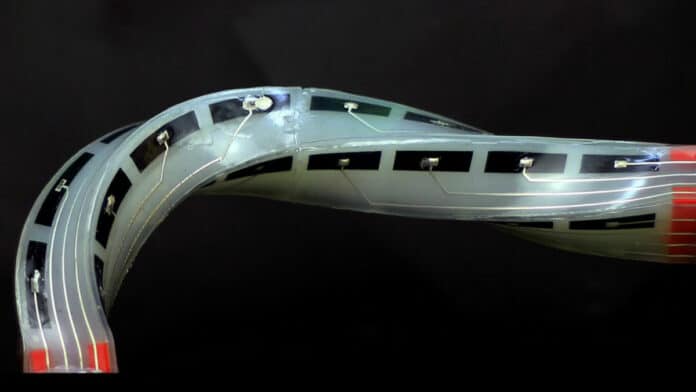Many robotic tasks require knowledge of the exact 3D robot geometry. However, this remains extremely challenging in soft robotics.
Now, a team of researchers at the University of Edinburgh has developed a smart electronics skin that could pave the way for soft, flexible robotic devices to assist with surgical procedures or aid people’s mobility. The stretchable e-skin gives robots for the first time a level of physical self-awareness similar to that of people and animals, researchers say.
The technology could aid breakthroughs in soft robotics by enabling devices to detect their movement in the most sensitive of surroundings precisely. Soft robots with e-skin could have a range of applications, including surgical tools, prosthetics, and devices to explore hazardous environments.
Unlike traditional rigid robots, which have a set range of movements, soft robots are highly flexible. This poses a major challenge to developing the sensing systems that are essential for robots to carry out precise tasks and interact safely with people and the environment, researchers say.
Without effective proprioception technology that can sense 3D shapes, it is hard for soft robots to understand their own speed, shape, and weight and how these qualities interact with their environment.
The University of Edinburgh team, working with the University’s commercialization service, Edinburgh Innovations (EI), has developed a proprietary technology that overcomes this problem. It provides soft robots with highly accurate, real-time sensing abilities.
“The perceptive senses endowed to robotic devices by this new technology are similar to those of people and animals. This new level of physical self-awareness represents a step change in the sensing capabilities of soft robots,” said Dr. Yunjie Yang of the University of Edinburgh’s School of Engineering, who led the study.
Researchers created a flexible e-skin made of a thin layer of silicone embedded with wires and sensitive detectors. Using the 1mm thick e-skin in combination with artificial intelligence software, the team was able to give soft robots the ability to sense things only millimeters away, in all directions, very quickly.
They tested their e-skin by fitting it to a soft robot arm. The technology was found to be able to sense a range of complex bending, stretching, and twisting movements across every part of the device. Thanks to the flexibility and size of the technology, it could be applied to almost any type of soft robot to enable it to accurately perceive its own shape and movements.
“The flexibility of the technology we have developed means it could be applied to various soft robots to enable them to accurately perceive their own shape and movements,” said the study co-leader Dr. Francesco Giorgio-Serchi. “Ultimately, that means we are now closer to making some of the most exciting ideas in soft robotics a reality.”
Journal reference:
- Delin Hu, Francesco Giorgio-Serchi, Shiming Zhang and Yunjie Yang. Stretchable e-skin and transformer enable high-resolution morphological reconstruction for soft robots. Nature Machine Intelligence, 2023; DOI: 10.1038/s42256-023-00622-8
